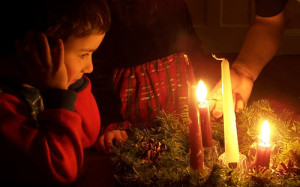 Did you know that the church actually divides what we think of as “Christmas Time” into two different seasons? It’s true. The first season is Advent which is the four weeks leading up to Christmas. The second, Christmastide, is when we actually celebrate Christ’s birth. Don’t feel bad if you didn’t know. Christmastide is a short season. It’s twelve days to be exact. As an additional “fun fact,” the season after Christmastide is Epiphany (the twelfth day after Christmas) when Christ is revealed to the gentiles or as we know it , when He gets a visit from the three wise men. So although you may be singing “The Twelve Days of Christmas” on December 25th, an Advent Wreath can be an excellent way to build excitement, anticipation and understanding of the season with the whole family!
Did you know that the church actually divides what we think of as “Christmas Time” into two different seasons? It’s true. The first season is Advent which is the four weeks leading up to Christmas. The second, Christmastide, is when we actually celebrate Christ’s birth. Don’t feel bad if you didn’t know. Christmastide is a short season. It’s twelve days to be exact. As an additional “fun fact,” the season after Christmastide is Epiphany (the twelfth day after Christmas) when Christ is revealed to the gentiles or as we know it , when He gets a visit from the three wise men. So although you may be singing “The Twelve Days of Christmas” on December 25th, an Advent Wreath can be an excellent way to build excitement, anticipation and understanding of the season with the whole family!
What is an Advent wreath?
An Advent wreath is a teaching tool that marks the passage of the four weeks of Advent which families and church use to aid in worship and devotionals. It can be made with evergreens, wood, or metal and is laid on its side so that it can support four candles.
How does it work?
Churches commonly elevate their wreath by placing it on a stand or hanging it from the ceiling so everyone can see, but many families like to place theirs on a mantel or even the kitchen table. Each Sunday starting with the first Sunday of Advent a candle is lit. Candles can be lit before dinner, as an evening family devotional, or at any time that’s a good time to talk about what they mean.
What do the candles mean?
Traditionally, there are three blue candles and one pink. Some churches use purple, as in Lent, because it is a penitent color. Most Episcopal churches, however, use blue which symbolizes hope. A white candle is added on Christmas Day.
The first candle to be lit represents hope. It reminds us that we have a faithful God who will fulfill His promise to send a savior.
The second candle to be lit represents peace or preparation. We are reminded to make room in our hearts, in our lives and the lives of others to allow the Holy Spirit to bring us His peace and awareness of our savior.
The third candle represents joy. We have a cause to celebrate! The coming of a savior means that we will be reconciled with our creator. That although we live in a broken world that still suffers from sin, we are not alone! We have a savior, a protector, who frees our hearts to happiness.
The fourth candle (pink or blue) represents love. Some traditions burn a pink candle to honor Mary, the mother of Jesus. She is an example of love and devotion which we will hear in our readings on the fourth Sunday of Advent (Luke 1:39-55) but even beyond Mary, our creator sent a savior because he didn’t want to be separated from us. He loved us! “For God so loved the world that he gave his one and only Son, that whoever believes in him shall not perish, but have eternal life. For God did not send his Son into the world to condemn the world, but to save the world through Him.” (John 3:16-17)
Some may also place a plain white candle, known as the Christ Candle, in the center of the Advent wreath. Jesus was the pure sacrifice sent to wash away our sins. God’s literal life on earth is the hope of our salvation and we honor this event on Christmas Day.
Is there a good prayer to end such a devotional with my family?
Prayer is always a good way to end a devotional. Consider using a prayer that is common in your family; pray freely by thanking God for this opportunity to better understand the meaning of Christmas, or you may want to use something from the Book of Common Prayer.
O God, you make us glad by the yearly festival of the birth of your only Son Jesus Christ; Grant that we, who joyfully receive him as our Redeemer, may with sure confidence behold him when he comes to be our Judge; who lives and reigns with you and the Holy Spirit, one God, now and forever. Amen. (BCP p. 212)
